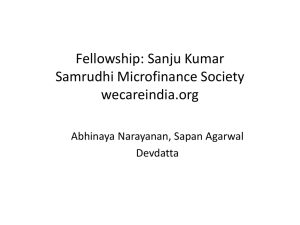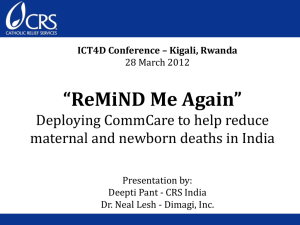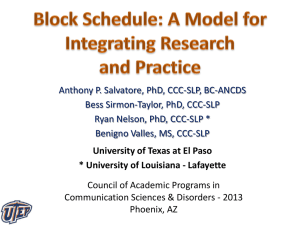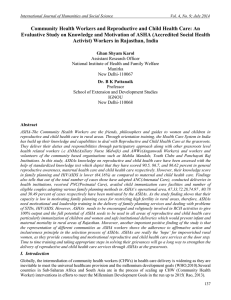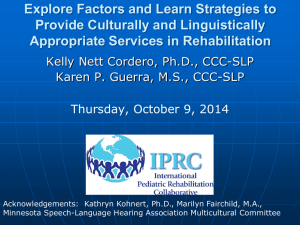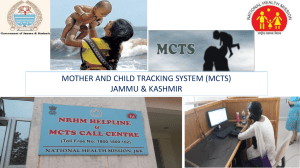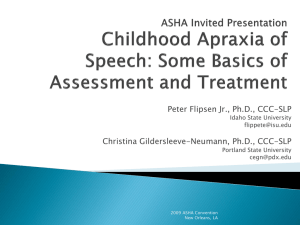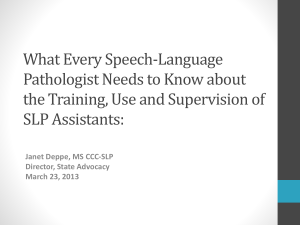CP - 24-12-2013 - Community Action for Health
advertisement
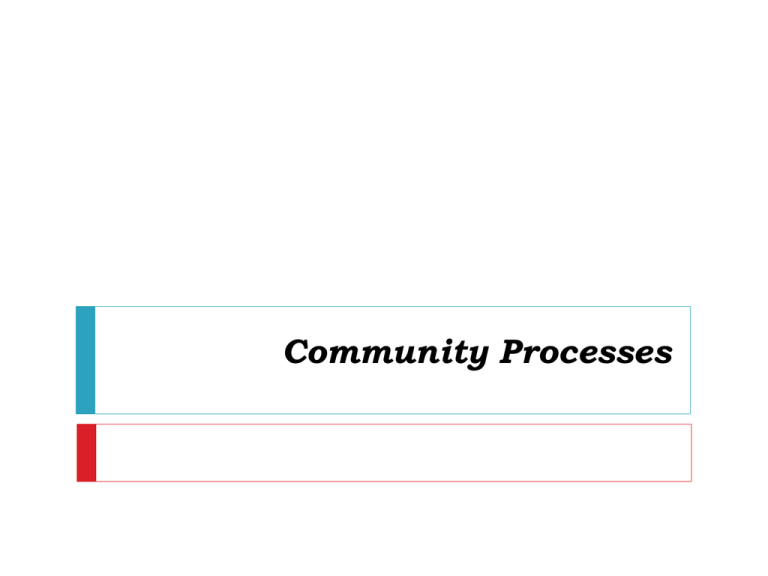
Community Processes Key elements of community processes under NHM The ASHA and her support network at block, district and state levels. The Village Health Sanitation and Nutrition Committee (VHSNC) and Mahila Arogaya Samiti (MAS). Untied funds to the Sub Centre and the VHSNC District Health Societies and the Rogi Kalyan Samitis Community Monitoring NGOs participation ASHA’s roles A. B. C. - A facilitator or link worker – where there is low use of health services, the ASHA enables people to access health services A volunteer and activist- to enable access to health entitlements and reaching the marginalized. A community level care provider- important for her credibility, to respond to local health needs, particularly in underserved areas. Closely linked to health outcomes Each of these roles reinforces the other but Getting the mix right is the challenge Working Arrangements Flexible work schedule Workload to be limited to 3-5 hours per day on about 4-5 days per week This would mean in most contexts- ASHA work will not adversely affect her primary livelihood. During mobilization events, Eg- pulse polio, or escorting a patient, she may spend a full day, and would be compensated accordingly. Such full day work cannot be made mandatory except for training programmes. Immediate field level support will be provided by both ASHA Facilitator and the ANM. ANM’s focus will be in her skills for community level care and identification of illnesses Facilitator’s role will be on supporting her in her activist role, in mobilization and in reaching the marginalized. Important Milestones and Current Figures 2006: ASHAs for 18 high focus states and in tribal districts in others Target 400,000 ASHAs 2009: Scaled up across the country. Now: 8.57 lakh ASHAs in 31 states / Uts (except in Goa, Puducherry and Chandigarh). Selection of ASHAs is underway in Himachal Pradesh State High Focus States North Eastern States Non High Focus States Union Territories Total Proposed Number of ASHAs 520725 54598 357506 870 933699 ASHAs selected % Selection 483320 54464 318417 806 857007 92.8% 99.8% 89.1% 92.6% 91.8% Selection of ASHAs Experience of selection at field level is mixed Challenge of selecting ASHAs in areas with poor indicators and small (dispersed) population still remains in few states Eg- MP, UP, Rajasthan, Bihar and Gujarat. Vacancies created by ASHAs progressing to become ASHA Facilitators are yet to be filled in states like MP and Bihar. In states like UP the newly selected ASHA facilitators continue to work as ASHAs – which has increased their work load immensely. Non resident ASHAs selected in states of Kerala and MP to adhere to the educational criteria There is a need to plan for at least 5% annual turnover of ASHAs Competencies and skills of the ASHA General: Rapport building, communication, village meetings Maternal Health: Birth planning, enabling ANC, health and nutrition education, understanding labour and delivery, understanding birth outcomes, and high risk identification and appropriate referral, Home based Newborn Care: essential newborn care, breastfeeding, weighing , measuring temperature, Sick newborn care: knowledge of risks and care of LBW and pre-term baby, manage breastfeeding problems, skill to identify and provide first contact care for sepsis. 1. 2. 3. 4. 10 Competencies and skills of the ASHA 5. Child care: nutrition counselling, identifying malnutrition, follow up, immunization, community based care for diarrhoea, Acute Respiratory Infections (ARI), and fever, De-worming and treatment of anaemia, 6. Women’s health and gender concerns: social determinants of women’s health – life cycle approach, violence against women. 7. Abortion, FP, STI/RTI: pregnancy test, counselling, identifying newly married and those with one child, distribution of spacing methods, appropriate referral for early abortion, counselling on safe sexual behaviour, 8. Communicable diseases: state specific: knowledge about prevention, early diagnosis, treatment access and follow-up. 9. Village Health Planning: Village planning, interpretation of basic data 11 ASHA Training Induction Training – (Modules 1-5) On her role and responsibilities, provide the skills of community rapport building and leadership, and develop an understanding of the health system and for rights based approach to health. Originally consisted of 21 days of training in five module ; but now modified to an eight day training in one Induction Module 1. 2. Module 6 & 7- 20 day training to be completed in four rounds. Consists of key competencies in maternal, new born, children’s health and nutrition 12 ASHA Training 3. Supplementary or refesher Trainings At least 15 days of training annually planned in which new topics and skills can be added, or to reinforce existing skills in areas where the ASHAs need further inputs. The new skills would be specific to local needs such as gender based violence, disability screening, mental health counselling, palliative care, NCD PHC review meetings can be used as a forum for such training 13 Training Module 6 &7 is underway in all states Adherence to training protocols assure training quality of State and ASHA trainers Gaps noted in ASHA training in few areas mainly due to logistics and poor management issues. On site mentoring of ASHA trainers reported only from MP and Bihar where systematic monitoring of ASHA training is undertaken. States of UP, Rajasthan, J & K, Kerala and Haryana lag in training ( Round 1 is underway) Refresher training of ASHAs in Rd 1-3 of Module 6 &7 is underway in UK Monthly meetings used for refresher training of ASHAs in Tripura – :Varsho Divas” Challenges – Procurement is the biggest hurdle faced by states in timely rollout of trainings. Timely release of funds Shortfall of training venues at block level Adequate skills and number of trainers Lack of systematic monitoring of training to ensure quality ASHAs have completed 1st 3 rounds of Module 6 & 7or more than 60% have been trained in Round 3 More than 70% ASHAs trained in round 1 and more than 50% ASHAs have also completed round 2 Less than 50 % ASHAs trained in Round 1 and Round 2& 3 training is also underway States where Round 1 is on going States which have completed training of trainers Support Structures for Community Processes State • MD, NRHM • ASHA Resource Centre • State ASHA Mentoring group District • District ASHA Coordinator/ Mobilizer • DPMU/District Health Society Block • Block Community Mobilizer • Block Programme Manager • ASHA Facilitator Sub block • VHSNCs 16 Formation of Position of states in 2010 Dedicated Support Structures Current Position of states 2013 Support Structures at all Four Levels Chhattisgarh , Uttrakhand Assam Maharashtra Bihar ,Chhattisgarh ,Jharkhand, Madhya Pradesh, Rajasthan, Uttrakhand, Assam, Tripura Maharashtra, Haryana Three Levels Bihar, Jharkhand, Rajasthan Arunachal Pradesh, Meghalaya Orissa, Uttar Pradesh Arunachal Pradesh, Manipur, Meghalaya, Mizoram, Nagaland Karnataka , Punjab Two Levels Madhya Pradesh , Orissa Tripura Delhi, Karnataka, Punjab, Delhi, Sikkim, Gujarat Only at one level Uttar Pradesh Andhra Pradesh, Gujarat, Kerala, Andhra Pradesh, Jammu & Kashmir Kerala, Tamil Nadu, West Bengal None; Programme managed by Existing NRHM Staff Manipur, Mizoram, Nagaland, Sikkim Haryana, Jammu and Kashmir, Tamil Nadu, West Bengal Four levels Three levels Two levels Only at one level Support Structures Substantial progress in establishing support structures across states Except Odisha and UP, all high focus states have support structures at four levels. North Eastern states have 3-4 levels of support structures Non high focus states like Andhra Pradesh, West Bengal, Tamil Nadu, Kerala, and Jammu & Kashmir have support structures only at one level. Capacity building of support structures is underway in most states but quality of inputs need to be improved ChallengesLack of mobility support Poor feedback and handholding Use of their time for other NRHM activities like data entry and accounts management Monitoring the functionality of the ASHAs 1. Indicators to be monitored: Newborn visits on first day of birth in case of home deliveries 2. Set of home visits for new born care as specified in the HBNC guidelines (six visits in case of Institutional delivery and seven in case of a home delivery) 3. Attending VHNDs/Promoting immunization 4. Supporting institutional delivery 5. Management of childhood illness – specially diarrhoea and pneumonia 6. Household visits with nutrition counselling 7. Fever cases seen/malaria slides made in malaria endemic area 8. ASHAs acting as DOTS provider 9. Holding or attending village/VHSNC meeting 10. Successful referral of IUD/female sterilization/male sterilization cases and/or providing OCPs/Condoms 20 ASHA facilitators will collect information from ASHAs during monthly meetings. ASHAs are not required to keep any additional records and use their planning tools to provide this information. 1 A compiled report is submitted by the facilitators to the block office on a monthly basis. Block Coordinators in turn consolidate the report monthly and submit it to district coordinators on a quarterly basis. Districts will report the functionality of blocks in terms of Grades A (>75% ASHAS functional on all indicators, Grade B (50-75% ); Grade C (25-50%) and Grade D (<25%) . No numbers regarding functionality are to be reported by the district to the state State and National level will only specify the percentage of blocks with the grades A, B, C and D against the total number of blocks 2 3 Performance Monitoring Introduced in the year 2011-12 to enable identifying gaps and take corrective actions at each level – district/ block / sub-block Attempt is to enable a shift away from monitoring as a punitive process – tool for supportive supervision Regular reports received from UK, Jharkhand, Delhi, Punjab, Karnataka and all NE states Repeated refresher training needed, for effective use of information and linking with health outcomes. . Incentives and Payments A mix of monetary and non monetary incentives: Performance based incentives for over 30 specific tasks Findings from surveys and evaluations show that ASHAs earn on an average – Rs.100 – Rs. 2000 per month. Over 90% ASHAs have bank accounts and most common mode of payment is by cheque or e transfers Single Window payments started in Odisha, Assam, UP and few districts of Bihar and MP. Fixed + Performance based incentives provided in Sikkim, Kerala, Rajasthan, West Bengal Matching amount of the incentive earned annually given in Karnataka, Meghalaya and Tripura (33% of the amount earned) Payments through Gram Panchayat have been introduced in Chhattisgarh Delays have reduced but it still takes up to 15 days – one month for payment of ASHA incentives 23 Non Monetary Incentives • • • • • • ID- cards for self esteem and helps to negotiate the health center. ASHA help desk,ASHA rest houses,ASHA help line Pension schemes, welfare fund, Scholarships, Career progression avenues ASHA Radio /ASHA newsletter, Common uniform, Bicycle, cell phones, umbrella Drug Kit One time drug kit distribution made in all states but replenishment is an issue Stock outs of many drugs including ORS and IFA is a regular feature Refilling is done in an adoc manner – when ASHAs report stock out during their facility visits, drugs are provided to them based on availability. Grievance Redressal MoHFW sent guidelines to states to constitute Grievance Redressal Committees in 2011-12. Status Odhisha, Uttrakhand, Sikkim, Manipur, Nagaland, Mizoram, Maharashtra, Gujarat, Karnataka and Kerala have set up district level Grievance Redressal Committees as per the guidelines Rajasthan, UP, Assam, AP, Haryana and Jammu & Kashmir use a common Grievances Redressal call centre for ASHA grievances also Other states are yet to initiate mechanisms for grievance redressal. Village Health and Sanitation Committees Over 500,000 VHSNCs across the country; GP/Revenue village level Key platform for social determinants and convergence at village level Experience demonstrates effective VHSNC functioning where ASHA has a convening role- mutually supportive Lack of support / training / hand -holding districts/ states where NGOs were involved. Revised Community Process launched in 2013 States are expected to restructure existing VHSNCs accordingly – to enable active participation of PRI and role of member secretary for ASHAs. Draft Training manual for trainers and VHSNC members is being devleoped. for VHSNCs except in few Mahila Arogaya Samiti (MAS) One MAS for every 50 to 100 HHs (4 MAS in every ASHA’s area) Annual grant of Rs.5000 from NUHM to each MAS every year. Strong focus on using or aligning with existing community groups Community structures like Neighborhood Groups (NHGs) and Neighborhood Committee (NHC) created under the Swarna Jayanti Shahari Rojgar Yojana (SJSRY) Women and Children in Urban Areas groups of at least 10 urban poor women and Thrift Credit Groups (TCG) Involving NGOs and Civil Society Organizations As Additional Technical Capacity and as Innovators Active Participation in ASHA Mentoring Groups Being National Training Sites . Bihar : training is NGO led, consortia based – at state and district levels West Bengal and Uttarakhand: building on the mother NGO scheme Training programmes for VHSNCs in almost all states wherever it has happened. Enabled community monitoring But still there is much more scope……streamlining mechanisms for selection and funding needed ASHA Programme in Gujarat Selection – 31839 ASHAs – 90% of the target (35237) Training Quality of training varies across districts - Training methodology altered – 20 days training completed in 5-10days in some districts. Full time availability of trainers is an issue – mostly from government health departments who find it difficult to devote time for training. Need to expand the pool of trainers to enable monitoring and ensure quality Refresher training in skills of Module 6 & 7 for all high focus districts/ blocks Rapid assessment of Module 6 & 7training in all non high focus districts is an immediate priority – to be followed by need based refresher training of ASHAs Kits – Drugs and HBNC – available but replenishment is an issue Payments – Process streamlined yet delays reported – varies across districts. ASHA Programme in Gujarat Support – Using existing structures at district and block level – but that seems to be working well Since all ASHA facilitators are not trained in training modules of ASHAs, quality of mentoring support was found to be poor. Training of all ASHA Facilitators should be done in induction module and Module 6 & 7 + Handbook for ASHA Facilitators Regular monthly meetings of ASHAs conducted by PHC MOs – Can be used for refresher training sessions. Performance Monitoring – yet to be introduced Need to expand the role of Civil Society – Taking trainers or sites from NGOs (for ASHA/VHSNC) Regular AMG meetings and allocation of districts to members Community monitoring ASHA certification programme Worked out in coordination with National Institute of Open Schools. Certification of Training sites, trainers, Training curriculum, ASHA Facilitators and ASHAs Levels Level-1 Entry Certification: Those already on the job – more like an identity and entry for phase 2. Corresponds to modules 1 to 5 or 8 day induction module. Level 2: Intermediate Certification: corresponds to skills in Modules 6&7 30% on internal- post training evaluation and assignments 40% on practicals- internal with some degree of externality- and 30% written examination: purely external. Level 3 Certification: special skills- general community health nurse; mental health, disability, advanced RCH etc. 33 Matching aspirations, work loads and skills. Increase Career Opportunities : the CP facilitator, AWW, ANM, paramedics, Elected panchayat members & Community Health Nurses As we approach 30 hours of work ( 6 hours per day * 5 days per week) we need to consider Level- 3 certificate and a regular income. As work exceed 40 hours of work a week ( 8 hours per day * 5 days per week) we need to consider a second ASHA Need to plan for a transition over two plan periods from a CHV or a CHW programme to a Community Health Nurse Programme New roles for ASHAs - Non-communicable diseases, disability screening, palliative care and addressing violence against women at the community level etc. 34 Thank You

